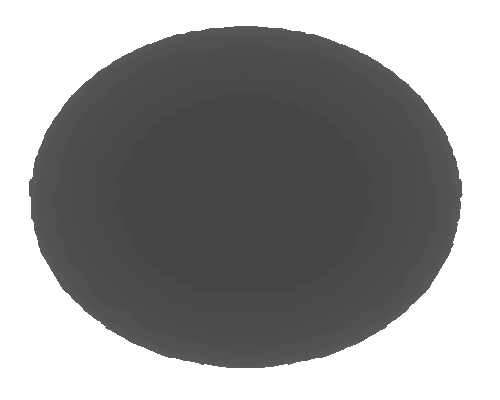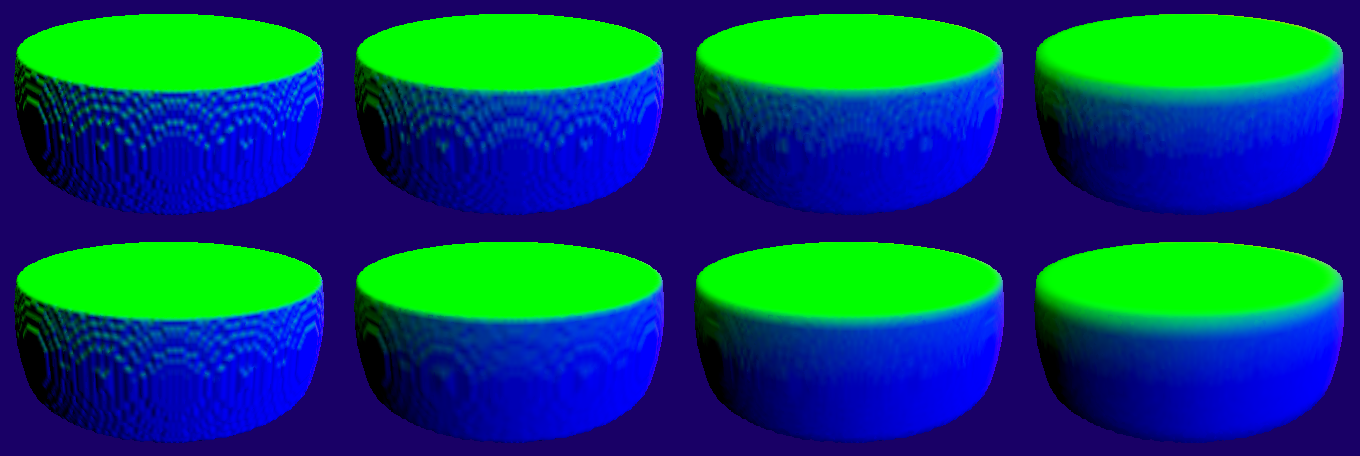Check incredible stuff on rendering and modeling with implicit surfaces:
- http://graphics.cs.illinois.edu/papers/zeno (paper with the technique)
- https://www.youtube.com/watch?v=s8nFqwOho-s (how to create a scene with them)
- http://iquilezles.org/www/articles/raymarchingdf/raymarchingdf.htm
The distance function is created using a generator function of type is_gen (for implicit surface). df_build will then fill the grid f, of dimensions n, with fn(x,y,z).
void df_build(df *o,
ivec3 n, float *p, // canvas / output buffer
vec3 center, vec3 half, // AABB
is_gen fn, void *arg); // implicit surface generatorThe program will then upload this distance-field grid into a OpenGL 3d texture. For this we will draw a quad filling up the screen (the canvas), and the setup the apropriate shaders.
The drawing process is a little diferent from a triangle rasterization method since we define the geometry as a distance function. For each pixel we'll trace a ray from the camera and try to hit the value 'zero' of the object (its surface by definition).
void main() {
vec3 ro = (u_i_pvm_mat * vec4(f_ro, 1)).xyz; // ray origin in tex space
vec3 rd = (u_t_pvm_mat * vec4(f_rd, 0)).xyz; // ray direction in tex space
float d = trace(ro, rd, MAX_ITERATIONS, final_distance);
if (final_distance <= EPSILON) { // found the object
...
}
}
float trace(vec3 ro, vec3 rd, int n, out float off) {
float radius=0.0, d=0.0;
for(int i=0; i<n; ++i, d += 1.02*radius) {
vec3 s = ro + d * rd;
radius = scene(ro+d*rd);
if (radius < LIMIT) {
break;
}
}
off = radius;
return d;
}With this we have a very resonable 3d representation of the object, however for lighing porposes we'll still need to reconstruct its normal for each pixel.
A drawing of the z-buffer / depth value.
As mentioned above we want the normal. The simplest function for this has a problem, the grid is very visible from it (as you can see below).
Below we use a diferent function and do a comparison with this one.
- X axis: epsilon in voxels.
- Y asis: diff method.
- from left to right epsilon in voxels: 0.25 | 0.5 | 1.0 | 2.0 | 4.0 | 8.0
- from top to bottom diff method: simple | sobel
- from left to right epsilon in voxels: 0.5 | 1.0 | 2.0 | 4.0
- from top to bottom diff method: simple | sobel
As you may have noticed, the objects above were not a sphere. They are a "derivate" object constructed by combining primitives.
A reason to why use distance fields is that.
Let a and b be the distance fields of 2 objects somewhere in space (x,y,z). The basic operations are as follows:
float union(a,b) = min(a, b);
float intersection(a,b) = max(a, b);
float subtraction(a,b) = max(a,-b);If you do this for each voxel of the grid, you will combine the two objects. The above images are subtraction(box, sphere) and the union(box, sphere).
https://www.youtube.com/playlist?list=PLucR9Mb5RnPMTDRqHdZI953NbLpUZIgSm


